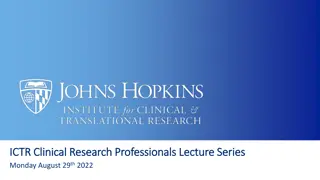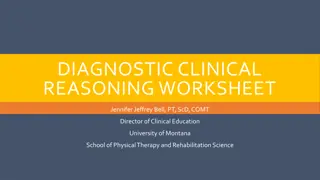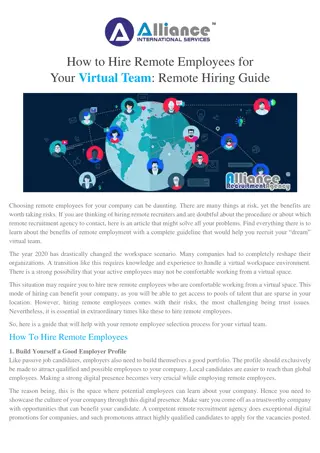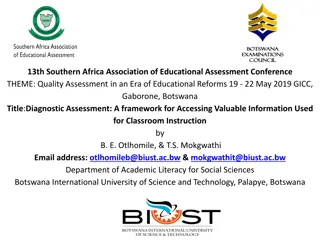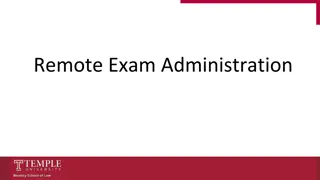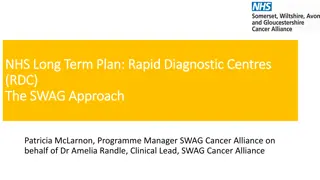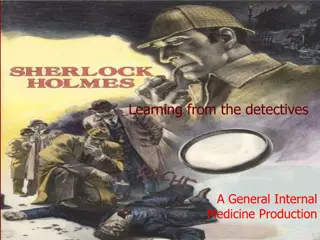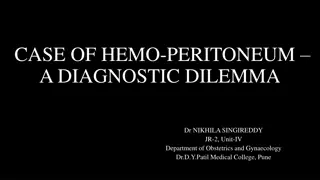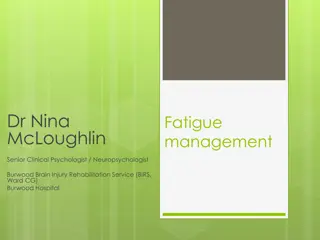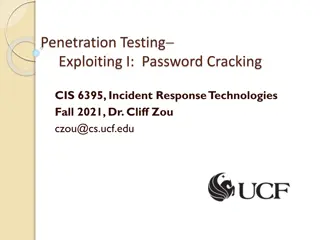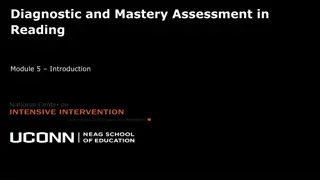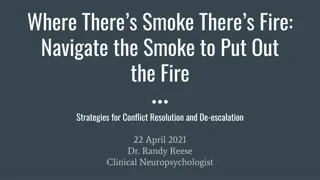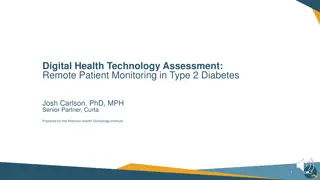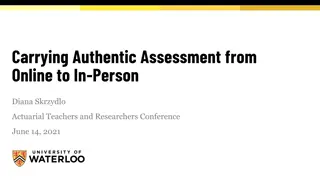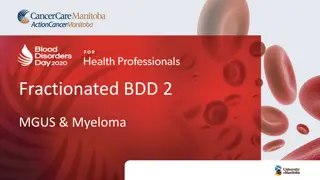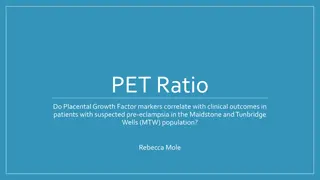Remote Diagnostic Assessment Explained by Clinical Neuropsychologist
Remote diagnostic assessment, also known as telepractice, allows assessors and individuals to be in separate locations while using internet-connected devices for assessment sessions. A facilitator may be present for support, and precautions are taken to ensure confidentiality and integrity of the assessment process. Remote assessment is proven effective and recognized for diagnosing conditions like dyslexia. Training and practice are key for successful remote assessments.
Download Presentation

Please find below an Image/Link to download the presentation.
The content on the website is provided AS IS for your information and personal use only. It may not be sold, licensed, or shared on other websites without obtaining consent from the author. Download presentation by click this link. If you encounter any issues during the download, it is possible that the publisher has removed the file from their server.
E N D
Presentation Transcript
REMOTE DIAGNOSTIC ASSESSMENT DENISE THORNTON CLINICAL NEUROPSYCHOLOGIST, EDUCATIONAL PSYCHOLOGIST CO-FOUNDER: ASSOCIATION OF CHILD PSYCHOLOGISTS IN PRIVATE PRACTICE
WHAT IS REMOTE DIAGNOSTIC ASSESSMENT (ALSO KNOWN AS TELEPRACTICE) The assessor is in one geographical location whilst the student / adult is at a different location which can be miles apart. A good internet connection (ideally with other devices turned off to improve the band width available) and a secure software platform such as Zoom, Teams etc. is used . The assessor and the student join the web-based meeting via computers with audio and video capability, so the assessor can share the assessment materials on line. with the student. Although it sounds so complicated, in reality it is really simple once you get your head around the technology. Demonstration during the session
IS THAT REALLY ALL THERE IS TO IT? Sometimes a facilitator (i.e. parent, teacher, TA, carer) may be with the student to support for students with very poor handwriting or physical difficulties who need someone to scribe for them etc. However, the adult is asked to stay in view at all times e.g. behind or beside the student so it is not possible for them to prompt or help without this being obvious. Having a 2ndcamera helps to show what is happening, so that if the student keeps deferring to the adult etc. Parents are encouraged to withdraw if they cannot stop helping! Sometimes we use a 2ndcamera e.g. when a student cannot speak, so we can watch them point to their choice, of the assessment options, but this also helps to see more of the student, which shows better when students are constantly wriggling, clearly demonstrating anxiety etc. The 2ndcamera perspective is really helpful. Sometimes physical materials are sent on beforehand to be opened during the assessment and when completed they are sealed into the box or envelope again to be sent back to the assessor. Practice is the key, testing the technology is working before you start,. There is lots of training available but assessors need to practice so they feel confident before they work with students. You also need to check the student can see, hear, respond etc. Typically this is best done with the parent so they have some idea of what is going to be involved. Safeguarding - all the usual concerns and precautions - no recording of sessions as the test producers do not allow this. Training for online safeguarding is recommended.
IS IT POSSIBLE TO DIAGNOSE DYSLEXIA BY REMOTE ASSESSMENT? Yes absolutely also possible to do a hybrid , part remote and part face to face assessment. Remote assessment has been in used since the early 2000 s but more assessment materials were released by the test manufacturers in response to Covid. Remote assessment has only been recognised by the DfE for access arrangements etc. last week because SASC SpLd assessment Standards Committee had previously advised that remote assessment was not appropriate for SpLD assessments. The BDA, AChiPPP and many other groups have been working to address this reluctance to accept that remote assessment is valid - thankfully that problem has now gone. Reliability data for remote assessment is very good. The biggest issue is that anyone born before 1997 has not grown up emersed in the digital world children are much more confident with it adults, particularly older adults are less confident, but quickly become confident when they start using this technology regularly.
IS REMOTE ASSESSMENT JUST A RESPONSE TO COVID 19? No its been around much longer than that and growing in popularity as it allows more students to access professionals. However Covid has forced people to embrace the technology in a way they might not have otherwise done. We were moving in that direction anyway, just more slowly remote assessment gives improved access to assessors.
WHAT COSTS ARE INVOLVED IN REMOTE ASSESSMENT? Buying the digital resources, but Pearson who are one of the main providers, allow the sharing of digital resources between named people which means an assessment kit can be shared between several assessors in terms of cost but only one person can use it at a time. Passing it between people remotely takes less than 2 minutes so I have personal experience of 3 people sharing the same kit during a day without any problem. Some assessments can be bought on a pay per use basis, which is cheaper if you only use them occasionally. You need good internet and a decent computer. You cannot run the remote assessment from an ipad or phone.
ARE REMOTE ASSESSMENTS VALID ? Yes the research data is strong but the assessor has to use professional judgement to determine if the student can be assessed remotely. The assessor needs training and experience but a lot of training is currently free on line and there are many free resources to assist - see the Pearson Assessment website for training and free technical support , 1 to 1 technical mentoring etc. There is high in-person validity for assessments across modalities i.e. no real difference between the results when done face to face or remotely but any assessment is only as valid as the choice of test and the skill of the assessor. Professional expertise is paramount. Remote assessments have been found to be valid and reliable over time even when compared with face to face assessment there is also strong research evidence that video interviews and in person interviews give comparable information. Many students consider remote assessment to be more reliable as many report that they find face to face assessment more stressful and less representative of the way they work in schools, colleges etc. Those with anxiety, ASD or mental health issues often give the most positive endorsements
ARE REMOTE ASSESSMENTS PREFERRED BY STUDENTS ? Absolutely, they report it reflects their life experience i.e. using computers, typing rather than writing etc. For many students a more detailed assessment is possible, over several days in shorter sessions which avoids the impact of nights poor sleep on their performance, allows the assessor to observe if there is variable performance over different days etc. yes because they have no panic about getting to a strange location, meeting an unfamiliar person in a setting they are not familiar with. The technology is familiar to them, which helps their engagement and lowers anxiety
ARE THERE OTHER ADVANTAGES? Easier to gather information from discussion with parents, teachers, carers, they can fit the sessions in more easily The assessor has less travel and not carrying heavy cases. Students with attention problems find it easier with shorter remote sessions Easy to rearrange if the student/parent,/ school have forgotten they are out on a trip or not available - as there are no travel costs for the assessor. Students in extremely rural locations can still access assessors. Possible to do an initial introduction session to explain to the student what will happen and give them time to prepare themselves
FEEDBACK FROM PSYCHOLOGISTS AND SPECIALIST TEACHERS USING REMOTE ASSESSMENT An adult paramedic was struggling to write the follow up notes, previously given verbally. Prior to Covid 19. Remote assessment identified his Dyslexia without problem. He benefitted from several assessment sessions as they fitted in with his work shifts. I have conducted several hundred online assessment sessions with individuals from 7 years to adulthood and never had a problem with remote assessment In the 7 cases where I had assessed the student before Covid 19 and complete the review assessment remotely I found that the results were directly comparable in each case.
WHAT ARE THE DISADVANTAGES The assessment might be treated too casually e.g. TV in the background, still in PJs or in bed, trying to do the assessment on a phone while travelling on a bus ! Not all tests are available but Pearsons No objections letter allows other tests to be used remotely using video facility as long as no recording is made. Needs a laptop or ipad the recent push by the Daily Mail etc. to give every school student their own device to access learning has helped Needs good internet signal try to reduce the problem with bandwidth by switching off other devices.
ARE REMOTE ASSESSMENTS HERE TO STAY? Yes - students with physical and sensory challenges also benefit - but it is not suitable for everyone professional expertise, trial and error will identify when it is not appropriate. Phonological processing is certainly possible, speech and language therapists have been using remote assessment for years in remote settings. Feedback from assessors, clients, universities and schools has been very positive! Older assessors can continue working from their homes rather than travelling with heavy assessment kits - given the shortage of assessors this is an important factor.
FURTHER INFORMATION FROM The following websites have helpful information: BDA SASC BPS On-line training, guidance, protocols, demonstrations - Pearson Education/Assessment website Research evidence is extensive e.g. Hodge et al 2019, Temple et al 2010 Cullum et al 2006, 2014 Galusha-Glassock et al 2016, 2018 Meta- analysis - overview of all the studies Bearly et al 2017





